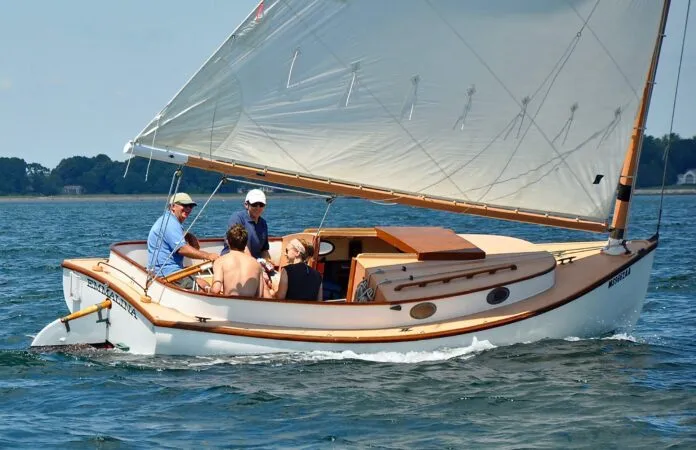
Catboats started out as workboats. According to marine historian Howard I. Chapelle, beamy, single-sailed centerboarders with half-decked hulls and barn door rudders began to appear in America around 1840, when, for the first time, there was sufficient demand to make fishing from small boats profitable. Sailed mostly in Lower New York Harbor and on Cape Cod Bay, cats fished, freighted, ferried, and packeted for decades. Their simplicity, stability, and shallow draft made them versatile, and their efficiency and ease of handling made them popular. Some say getting fish to market was the advent of sailboat racing.
In the 1880s and ‘90s, catboat racing flourished, especially around New York. In that Gilded Age, unlimited “sandbaggers” with sky-scraping gaffs and gangs of crew pushed the type towards its speed (and safety) limits. Throughout the years, catboats have also made fine yachts.
Built in wood by local yards, small cats suitable for daysailing and overnighting eventually became available as production boats. In more recent years, cats have enjoyed a minor renaissance. Fleets can be found at New Jersey and New England yacht clubs. The second life of the traditional cat began in 1962 when Breck Marshall built the first one in fiberglass. He went into limited production with an 18-footer called the Sanderling, named after the wave-skipping shore bird. His shop was in New Hampshire. He sold a few boats, but in addition to the problems of trying to sell the sailors of that day on “plastic boats,” he encountered resistance brought on by his location.
“People couldn’t imagine a boat like that being built in New Hampshire,” Marshall wrote. “But when I moved the company to Padanaram, Massachusetts, down to the saltwater and the natural habitat of the catboat, things picked up and we sold all the boats we could build.”
Marshall died in 1976, but shop foreman John Garfield bought the company from Marshall’s widow and kept filling orders. The Sanderling was the first “modern” catboat on the scene, but it has been joined over the years by a raft of reproductions, developments on traditional lines, and original designs, all built in fiberglass with aluminum spars.
In addition to Marshall’s 15-ft. Sandpiper and the Marshall 22, the list includes the 21-ft. Atlantic City Cat (affording both inboard power and 6-ft. headroom); the popular Nowak & Williams-built, Halsey Herreshoff-designed Herreshoff America Cat; One Design Marine’s Chappaquidick 25; the Wittholz-Hermann Cape Cod cat, (17-1/2-ft. overall); the Americat 22 (modeled after a Sweisguth design of the 1920s and built by Vintage Boat Co.), and a series of Menger cats (15, 19, and 23) from Menger Boatworks.
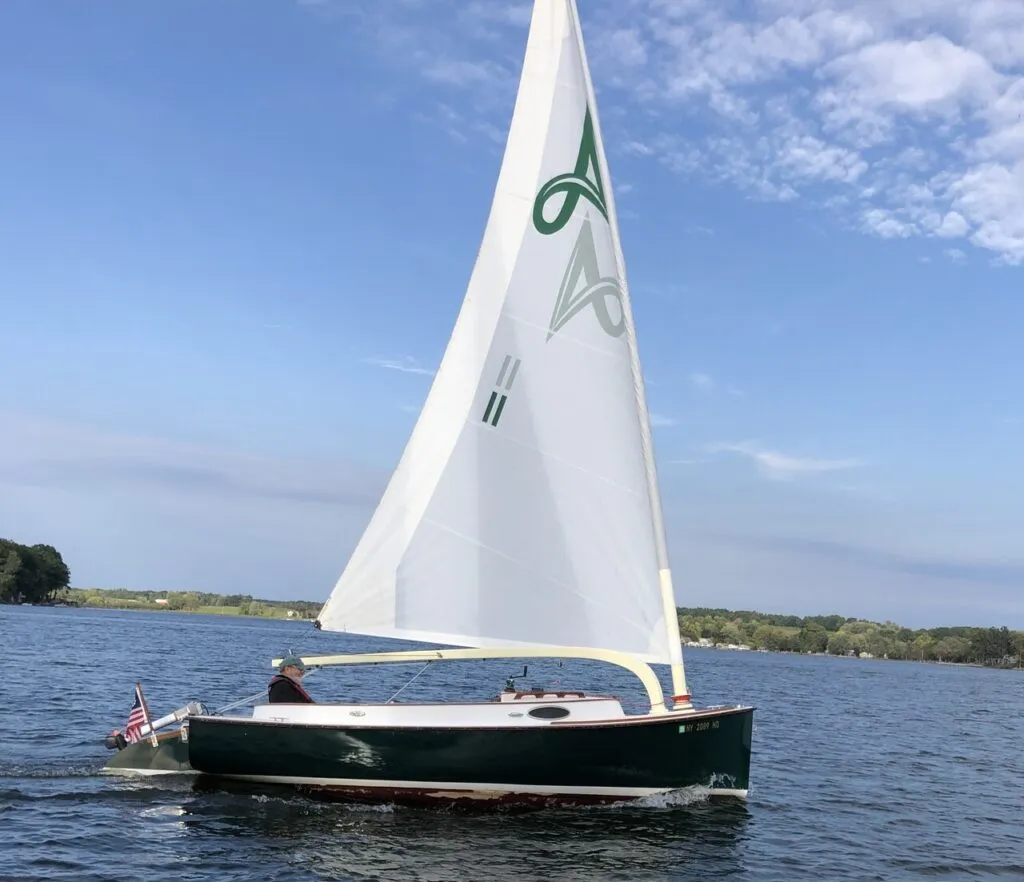
Garry Hoyt has always been a pioneer. In the 1970s he revived free-standing spars with his Freedom 40 and followed it with learn-to-sail boats like the Expo Solar Sailer and Escape, as well as a series of inventions that include the patented Hoyt Gun Mount and Hoyt Jib Boom. In 1998 he designed and built the 19-ft. Alerion cat “to combine the proven virtues of the catboat with modern sailing performance.” From the outset, cats have been recognized for their shallow-water capabilities, sprightly acceleration, superior load-carrying and stability.
Cat people will note the Alerion’s sleeved mainsail, which rolls around a free-standing mast on special Harken bearings. A green “go” line and a red “stop” line for shortening sail further simplify the system. Thirty seconds of pulling on control lines and it’s deployed. Friction in the system is minimal. The Jib Boom is the least-traditional element in the Alerion’s looks, but it facilitates precise and variable shape control as well as roller furling deployment.
Perhaps the most-radical of Hoyt’s innovations could be found in the rudder. Starting with the planform of the traditional shallow draft, low-aspect ratio “barn door,” Hoyt cut the rudder away below the waterline. The forward third of the rudder was a high-aspect ratio, foil-shaped pivoting blade. When drawn up, it filled the cutout and the rudder looked and worked like a typical cat’s barn door rudder. When deployed, it gave deep-draft control and high-lift efficiency. The configuration also helped address the legendary weather helm that has always been the catboat’s Achilles Heel.
Comfort and sailing ease are big parts of catboat appeal. The Alerion’s easy-handling sail systems, combined with the high coamings and maximum elbow room of the archetypal catboat cockpit, made Hoyt’s Alerion shine in these areas.
Sanderling 18
The prototype for the Sanderling was an 18-footer designed by Pop Arnold in 1941. Breck Marshall said he inherited some plans and a handful of station molds from his work with Bill Tripp at American Boatbuilding in East Greenwich, Rhode Island. But, he wrote, he had no plans of the boat that became the Sanderling. Marshall spent about three weeks modeling by eye before he built the plug for the first Sanderling. And the hull he ended up with was significantly different from the model.
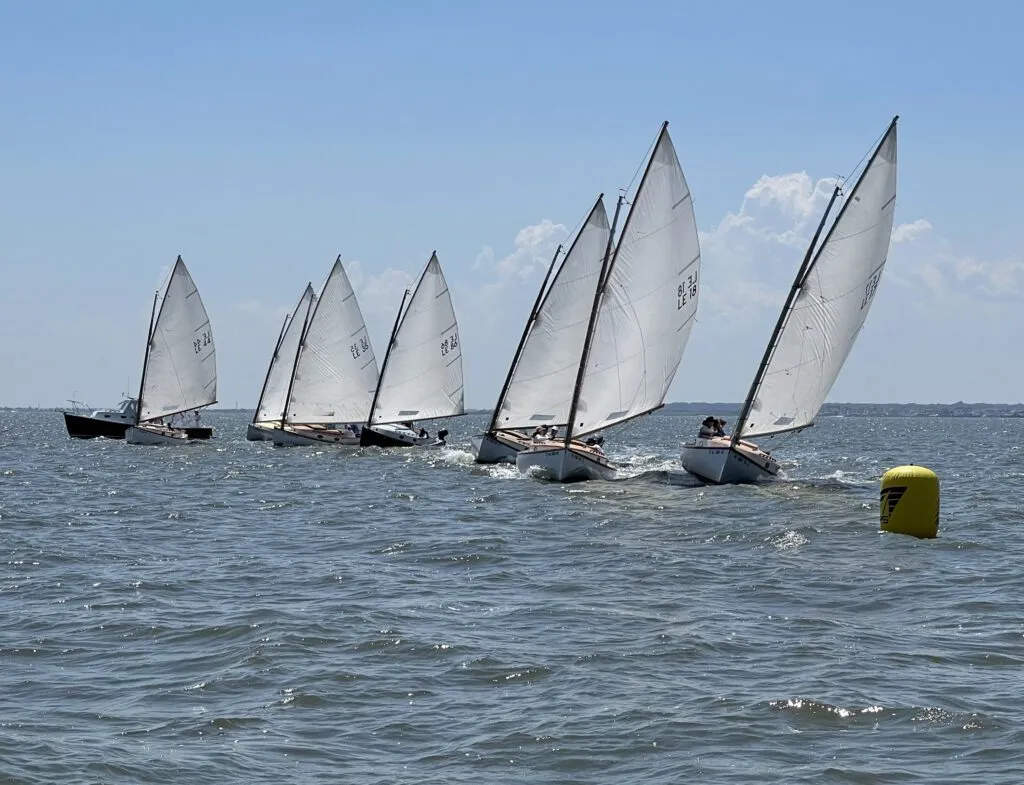
Sanderling’s entry was a major departure from the past. Catboats have always been close-winded (due primarily to the aerodynamic cleanness of a single sail) but only in smooth water. Because of the bluff, full bow sections necessary to buoy up their heavy wooden masts, Sanderlings have earned a bad name for going slowly upwind in waves. By using a lighter (less than 70 pounds) aluminum mast, Marshall was able to make the Sanderling’s entry considerably finer. Over the years, the boat that Marshall created has performed well enough upwind in waves to confirm the wisdom of that modification.
The Pop Arnold model, Marshall said, “was not a pretty boat. She had a flat sheer with a kind of tumblehome ram bow in her. She also had a square house.” Marshall corrected these deficiencies by giving the Sanderling a swept sheer, crowned cabin, tapered house, and slightly angled stem. Many modern eyes have never seen an original catboat, but, old or new, the catboat Marshall modeled is among the handsomest of the breed.
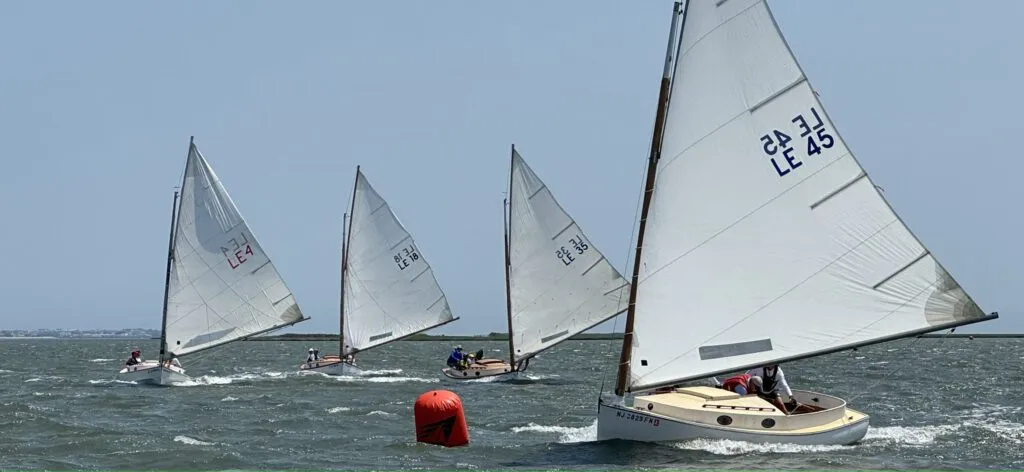
Says Garfield, “I think Marshall was influenced a lot by Bill Tripp. The waterplane of the Sanderling looks more like the underbody of a Tripp ocean racer of the time than it does the boxy traditional cats.” The Sanderling’s maximum beam of 8-ft. 6-in. and length overall of 18-ft. 2-in. approach the classic 1:2 proportions that distinguished the cats of old, but the waterline beam of less than 8-ft. makes it more modern under the water. So does the moderate deadrise (many cats are almost flat-bottomed) and tapered shape aft. It’s a marketing cliché today, but it seems to us that in the infancy of fiberglass boatbuilding Marshall combined traditional aesthetics with modern hydrodynamics. Catboats like the Nonsuch and certainly the Alerion Express Cat have continued the same theme of being old-fashioned to look at but up-to-date under the water.
Construction. The Pearson Triton, one of the earliest production fiberglass auxiliaries, was only four years old when Marshall built the first Sanderling in 1962. Coming from pioneering days, it was built to “more is more” scan’tlings. Building boats with glass and resin has come a long way since then.
“We introduced the chopper gun back in 1972,” Garfield said, “and as gelcoat has improved we’ve taken advantage of the changes. We use all isophthalic gelcoat and resins now. The battens inside on the overhead used to be wood. Now they’re closed-cell foam. We added a collar molding around the mast hole, but from the rail down is sacred. We build them today the way Marshall did then.”
Marshall Marine uses polyester resin and alternating plies of mat and woven roving for a total of seven in the hull and adds four more to make a total of 11 plies along the centerline and in the way of the centerboard trunk. The mast step is molded separately and taped in place, as is the trunk. The interior is rough glass textured by the final layer of roving, but the mat/gelcoat exterior shows surprisingly little print-through.
The hull/deck joint is an overlapping deck flange. Sealed with compound and bolted on 12-in. centers with 3/8-in. diameter stainless steel bolts (through a mahogany rubrail). It has kept deck leaks to “an absolute minimum” Garfield reports.

The owner of hull #66 (built in 1964) confirmed that “deck leaks have never been a problem. “We did, however, re-bed the ports two years ago because they were weeping. The only house leaks are through the bolt hole in the handrail where we popped out a wooden bung.
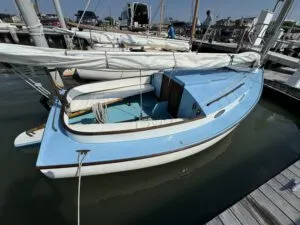
We also encountered rot in the aft house bulkhead due to water seeping through cracked fiberglass tape, and a centerboard leak where the glass encapsulating the pivot bolt cracked. The plywood floor of the cockpit has had to be reglassed in places where the original fiberglass sheathing wore away.”
Performance. Many modern sailors have never sailed a gaff-rigged boat. When we first sailed the Sanderling we found Hoyt’s criticism of “confusing hoops, lifts, and jacks” apropos. And certainly, if the gaff was a viable rig, why did it die? We’ve grown to see, however, that while it does take some getting used to, the gaff is not entirely outmoded. The flex in it is a good thing, similar to a modern flex-tipped mast. It bends to leeward and loosens the leech in the puffs. The gaff is also less bulky than even a modern full-length spar, and for that reason the upper part of the mainsail benefits from cleaner airflow upwind. Draft control is

surprisingly precise via adjustment of the peak (the halyard that lifts the middle of the gaff as opposed to the throat, which controls the inner end). Hoisting and dousing sail are more complicated operations, but then there’s only one sail to tend. There is no boom vang and the traveler isn’t adjustable.
The standard mainsheet trims from the end of the boom. This clears the cockpit for passengers. One owner said, “We bought a mainsheet cam cleat to mount by the after end of the centerboard trunk but we’ve never gotten around to it. It’s just simpler to wrap the sheet on the horn cleat aft.”
Sanderling’s big sail is good for ghosting. It has a relatively slippery shape and has the ability to reduce wetted surface a lot by heeling a little. “I’m amazed,” said one owner, “at how well she glides in breezes too light to see on the water. She may look clunky and complicated but she’s a joy to sail.”
Said another sailor, “we’ve made 6- and 8-hour passages in her and averaged better than 5 knots under sail. For an 18-footer she can cover the ground. We’ve been pleased at how she took rough weather (25 knots under single reef), too.”

More than 200 Sanderlings are raced in one-design fleets said Garfield. “That’s one of the reasons the boats haven’t changed much. Breck Marshall moved cats into fiberglass and used the materials and concepts of his day to improve the breed. Generations have embraced his design and the Marshall cat has become a mini-classic.
geoff@marshallcat.com

































We used to sail a Marshall 22 on the Long Island Sound, and took a couple of cruises up the coast. Great boats, fun to sailing, and a great owner community. One feature of the gaff rig we especially enjoyed was the ability to quickly reef by scandalizing the gaff, i.e. lowering the gaff to create a much smaller, triangular sail. Very helpful when easing up to a mooring buoy!
And a Sanderling won the singlehanded monohull class in this year’s race to Alaska!
Left my Sanderling (and a lot of great gunkholing territory) behind when I moved to San Diego.